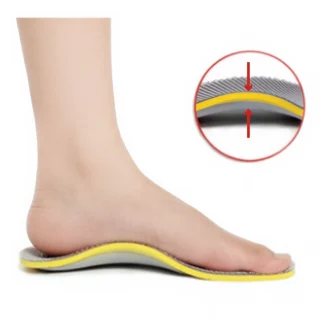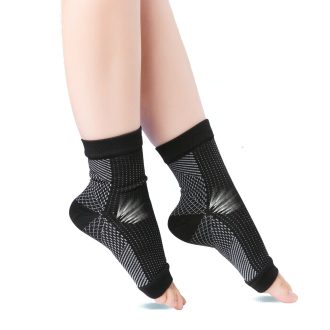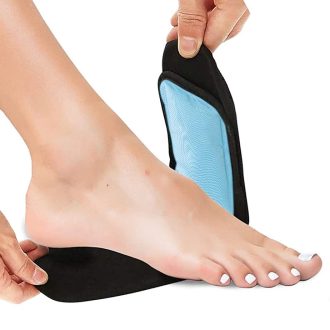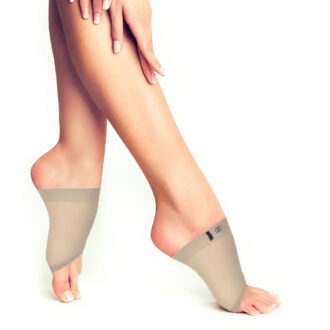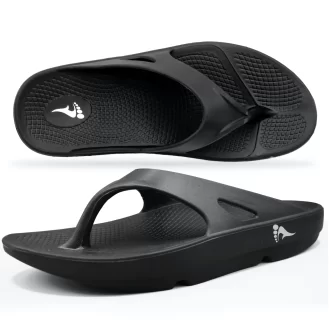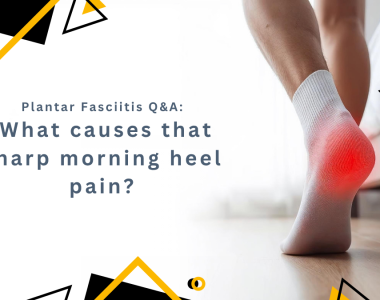No products in the cart.
Do I have Plantar Fasciitis?
Plantar fasciitis can be a perplexing and painful condition that affects many people, often causing discomfort with every step. In this installment of our Q&A series at NuovaHealth, we delve into a common concern raised by our community: the mysterious and persistent pain in the heel and foot. Our customer is experiencing sharp heel pain, particularly noticeable in the morning and after prolonged standing, and wonders if a recent change in footwear could be to blame. Join us as we explore the symptoms of plantar fasciitis, potential contributing factors, and practical advice to help alleviate this discomfort. Whether you’re dealing with similar symptoms or just curious about foot health, this discussion aims to provide clarity and support.
Hello NuovaHealth,
I hope you can help me figure out what might be going on with my foot. Recently, I’ve been experiencing some discomfort that I suspect might be plantar fasciitis. My heel feels inflamed and tender to the touch, and there’s a sharp pain in my heel when I take my first steps in the morning. It’s quite noticeable, and I’ve also observed that the pain seems to get worse after I’ve been standing for long periods. I’m wondering if this is typical of plantar fasciitis or if it could be something else. I started wearing a new pair of shoes not too long ago, and I’m curious if that might be contributing to the problem. Could the change in footwear be related to the pain I’m experiencing? Any advice or insights you could provide would be greatly appreciated as I try to get to the bottom of this discomfort. Thank you!
Why Does My Heel Feel Inflamed and Tender?
Hello and welcome! It sounds like you’re dealing with some frustrating foot pain, and I’m here to help you understand what’s going on. Heel inflammation and tenderness are often indicative of plantar fasciitis. This condition is quite common, affecting around 10% of people in the UK at some point in their lives. The plantar fascia is a thick band of tissue that connects your heel to your toes, playing a crucial role in supporting the arch of your foot. When this tissue becomes irritated, it can lead to significant discomfort. Not only does this result in heel pain, but if left unchecked, it can also affect your gait and the kinetic chain, potentially leading to issues in other parts of your body.
What Are the Typical Symptoms of Plantar Fasciitis?
If you’re wondering whether you might have plantar fasciitis, here are the key symptoms to look out for:
- Heel Pain:
- Look for a sharp, stabbing pain in the bottom of your heel.
- This pain is often most noticeable with your first steps in the morning or after long periods of rest.
- Tight Achilles Tendon:
- Check if there is a sensation of tightness or tension in your Achilles tendon, which connects your calf muscles to your heel bone.
- Pain After Exercise:
- Be aware if the pain increases after exercising or physical activity, though it usually doesn’t hurt during the activity itself.
- Stiffness:
- Notice if there’s stiffness in your heel or foot, particularly in the morning or after sitting for extended periods.
- Swelling:
- Observe for any mild swelling or inflammation in the heel area.
- Tenderness:
- Feel for tenderness at the bottom of your foot. It might be sensitive to touch.
By monitoring these symptoms, you can better assess whether they align with plantar fasciitis. Understanding these signs can help you make informed decisions about seeking medical advice for a proper diagnosis.
Causes and Risk Factors of Plantar Fasciitis
Understanding the root causes of plantar fasciitis is crucial for both prevention and management. Biomechanical imbalances play a significant role in the development of this condition. The plantar fascia, a vital structure in your foot, can become overstressed due to these imbalances, leading to inflammation and pain over time.
Biomechanical Imbalances:
Biomechanical imbalances refer to the way your body moves and the alignment of your bones and muscles. One common issue is pronation, which is the natural inward roll of the foot during walking or running. Overpronation occurs when this inward roll is excessive, causing the arch of the foot to flatten more than usual. This can lead to increased stress on the plantar fascia. Conversely, supination is the outward roll of the foot, and excessive supination can also strain the plantar fascia by placing extra pressure on the outer edges of the foot.
These imbalances not only affect the feet but can also impact the kinetic chain, which refers to the interconnected system of bones and muscles from your toes up to your back. Problems here can manifest as pain in your ankles, knees, hips, and even lower back, as the body compensates for the imbalance.
Who is Most at Risk?
Several groups of people are more susceptible to developing plantar fasciitis due to these biomechanical imbalances and lifestyle factors:
- Individuals with Flat Feet or High Arches: Both flat feet and high arches can lead to biomechanical imbalances. Flat feet may cause overpronation, while high arches can lead to excessive supination.
- Runners and Athletes: The repetitive impact and stress on the feet from running and other high-impact sports can increase the risk of plantar fasciitis.
- People Always on Their Feet: Occupations that require prolonged standing or walking, such as waiters, waitresses, and nurses, can put extra strain on the plantar fascia.
- Middle-Aged Adults: As we age, the plantar fascia can lose elasticity, making it more susceptible to injury.
Why Do I Feel a Sharp Pain in the Morning?
Now, let’s focus on those painful first steps in the morning you’ve described. You’re not alone in this experience, as it’s a hallmark of plantar fasciitis. During the night, your foot is at rest, allowing the fascia to tighten. When you take your first steps, the rapid stretching of this tissue triggers sharp pain because the plantar fascia is temporarily less flexible and less able to absorb the impact of pressure. Fortunately, as you continue to move, the fascia gradually loosens due to increased blood flow and gentle stretching, which enhances its flexibility and reduces tension. This loosening helps to alleviate the sharp pain as the fascia becomes more adaptable to movement.
Why Does the Pain Worsen After Standing for Long Periods?
Standing for extended periods, especially on hard surfaces like concrete or tiles, can exacerbate plantar fasciitis pain. The constant pressure on your feet can lead to micro-tears in the plantar fascia, increasing inflammation and discomfort. This is why incorporating rest into your routine is vital for recovery. Rest helps reduce inflammation and allows the tissue time to heal. Using a night splint can be particularly beneficial, as it keeps your foot in a dorsiflexed position overnight, gently stretching the plantar fascia and preventing morning heel pain. By understanding these aspects, you can take proactive steps towards managing and alleviating your symptoms.
Could My New Shoes Be Contributing?
Now, let’s consider your new shoes. Footwear plays a significant role in foot health. Shoes that lack proper arch support or cushioning can increase stress on the plantar fascia, potentially triggering or worsening symptoms. The College of Podiatry in the UK advises selecting shoes with good support and cushioning to help alleviate symptoms. It might be worth assessing whether your new footwear offers the necessary support.
Diagnosis and Importance of Medical Consultation
Seeking a proper diagnosis for plantar fasciitis is essential. A healthcare professional can perform a thorough examination, which may include a physical assessment and imaging tests, to confirm the condition and rule out other potential causes of heel pain.
Ignoring plantar fasciitis can lead to severe consequences. Chronic pain can alter your gait, leading to further issues in the kinetic chain, from your feet up to your back. This can result in conditions such as joint pain and muscle imbalances, significantly impacting your quality of life.
By consulting a doctor, you can receive a personalized treatment plan to address the root causes of your pain, helping to prevent further complications and promote healing. Early intervention can make a substantial difference in your recovery and long-term foot health.
Treatment Options for Plantar Fasciitis
The plantar fascia ligament is one of the slowest healing ligaments in the human body, and managing plantar fasciitis effectively requires a comprehensive approach to prevent reinjury and promote healing. Utilizing a combination of products and therapies can support recovery and alleviate symptoms.
Rest and Ice Therapy
Rest is crucial in managing plantar fasciitis. Minimizing activities that put stress on the heel will prevent further injury and allow healing. Ice therapy involves applying ice packs to the heel for 15-20 minutes, several times a day. It helps reduce inflammation and provides temporary pain relief. However, over-reliance on ice may lead to numbness or skin irritation, so it’s important to use it judiciously.
Stretching Exercises
Daily stretching exercises targeting the calf muscles and plantar fascia can significantly improve flexibility and reduce tension. Stretching helps in alleviating discomfort and preventing further injury. While generally beneficial, improper stretching techniques can potentially worsen the condition. It’s advisable to learn these exercises from a physical therapist. A physical therapist can design a personalized treatment plan that may include manual therapy and strengthening exercises. While effective, therapy may require a significant time commitment and can be costly without insurance coverage.
Pain Relief Medication
Over-the-counter pain relief medications, such as acetaminophen, can help manage the pain associated with plantar fasciitis. Anti-inflammatory medications like ibuprofen or naproxen are also effective in reducing inflammation. However, prolonged use of these medications can lead to side effects such as stomach irritation or increased risk of heart problems. Always take medications under the guidance of a healthcare professional and only from legitimate sources, such as your local pharmacy.
Surgery
In severe cases where conservative treatments fail, surgery might be considered. Procedures can involve releasing tension in the plantar fascia or removing a spur. The pros of surgery include a potential permanent solution to the pain. However, surgery comes with risks such as infection, nerve damage, or a lengthy recovery period. Therefore, it is considered only after careful evaluation by a medical professional.
Before taking any new medication or opting for surgery, it is paramount to consult with a healthcare provider. They can assess the risks and benefits specific to your condition and provide guidance tailored to your needs. Avoid self-medicating and always acquire medications from reputable sources to ensure safety and efficacy.
Products to Consider
Exploring supportive products can also bring relief. Here’s a look at some options:
Orthotic Insoles
Orthotic insoles are designed to correct biomechanical imbalances that contribute to the development of plantar fasciitis. By providing targeted support to the arch, these insoles help distribute pressure more evenly across the foot, reducing strain on the plantar fascia. This realignment can prevent additional stress on the ligament, aiding in both prevention and recovery. Look for insoles specifically designed for plantar fasciitis to ensure proper support.
Night Splints
Night splints are designed to maintain the foot in a dorsiflexed position throughout the night. This position helps to keep the plantar fascia and Achilles tendon elongated, preventing the fascia from tightening overnight. By maintaining this stretch, night splints can significantly reduce morning pain and stiffness, which are common symptoms of plantar fasciitis.
Braces
Foot braces provide support and stability, limiting movement that could exacerbate pain and inflammation. They can be especially beneficial during daily activities, offering additional support to prevent further stress on the plantar fascia. By stabilizing the foot, braces contribute to a more controlled environment for healing.
Compression Socks
Compression socks are designed to improve circulation, which can help manage inflammation and reduce swelling. By applying gentle pressure, these socks support not only the plantar fascia but also the surrounding tissues, promoting faster healing. Improved circulation ensures that the plantar fascia receives the necessary nutrients and oxygen to repair and recover.
Foot Ice Pack Wraps
Foot ice pack wraps are versatile tools that can provide cold therapy, heat therapy, and contrast therapy, offering a comprehensive approach to managing plantar fasciitis and other foot-related issues.
- Cold therapy with foot ice pack wraps is highly effective in reducing inflammation and numbing pain. By constricting blood vessels, the cold decreases swelling, providing relief from discomfort. Many wraps also offer compression, which aids in further reducing inflammation by restricting fluid accumulation, thus promoting faster recovery.
- On the other hand, heat therapy serves to relax and loosen tissues while stimulating blood flow to the affected area. This increased circulation delivers essential oxygen and nutrients needed for healing. Applying heat therapy before activity can prepare the plantar fascia for movement, reducing stiffness and minimizing the risk of further injury.
- Contrast therapy, which involves alternating between cold and heat treatments, combines the advantages of both methods. It stimulates circulation, helping to reduce inflammation quickly while promoting healing. This approach also supports the stretching and strengthening of the plantar fascia, facilitating a faster recovery.
By integrating these therapies, foot ice pack wraps provide a holistic solution to alleviate pain, enhance healing, and improve overall foot health.
Why Choose NuovaHealth?
At NuovaHealth, we pride ourselves on offering top-quality products tailored to alleviate discomfort associated with plantar fasciitis. Here’s why our products stand out:
- Innovative Design: Our products are crafted with the latest technology to ensure maximum comfort and support.
- Quality Materials: We use durable, breathable materials to enhance your comfort throughout the day.
- Proven Effectiveness: Backed by customer testimonials and expert recommendations, our range is designed to deliver results.
- Comprehensive Range: Whether you need insoles, splints, or compression socks, we offer a solution to meet your needs.
Explore our collection and take the first step towards alleviating your heel pain today!
-
Product on sale
 Arch Support Insoles for Plantar Fasciitis and Flat Feet£9.99
Arch Support Insoles for Plantar Fasciitis and Flat Feet£9.99£11.99inc VAT -
 Compression Socks for Arthritis, Plantar fasciitis, Diabetes, Neuropathy & Varicose veins£8.99inc VAT
Compression Socks for Arthritis, Plantar fasciitis, Diabetes, Neuropathy & Varicose veins£8.99inc VAT -
 Foot Ice Pack Plantar Fasciitis Wrap£8.99inc VAT
Foot Ice Pack Plantar Fasciitis Wrap£8.99inc VAT -
 Gel Arch Support Compression Sleeves for Plantar Fasciitis relief & Flat Feet£7.99inc VAT
Gel Arch Support Compression Sleeves for Plantar Fasciitis relief & Flat Feet£7.99inc VAT -
 Night Splint for Plantar Fasciitis & Achilles Tendinitis£11.99inc VAT
Night Splint for Plantar Fasciitis & Achilles Tendinitis£11.99inc VAT -
Product on sale
 Orthotic Arch Support Flip Flop Sandals for Flat Feet & Plantar Fasciitis£28.99
Orthotic Arch Support Flip Flop Sandals for Flat Feet & Plantar Fasciitis£28.99£34.99inc VAT
Conclusion
Based on what you’ve described, it’s possible you are experiencing plantar fasciitis. However, it’s crucial to consult a healthcare professional for a definitive diagnosis and personalized advice. They may suggest rest, stretching exercises, or even orthotic inserts to help manage your symptoms. Remember, while footwear can contribute to discomfort, it’s just one piece of the puzzle. Taking proactive steps now can lead to more comfortable strides ahead. Stay active, but listen to your body, and consider seeking professional guidance for tailored treatment options.
Thank you for reaching out, and take care!
